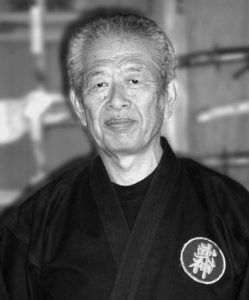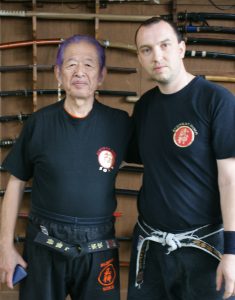Hatsumi Masaaki
Hatsumi Yoshiaki se narodil 2. 12. 1931 v Noda (severně od Tokia), později své křestní jméno změnil na Masaaki.
V sedmi letech se díky svému otci seznámil s Kendem, zabýval se i Judem a Karatem. Na střední škole cvičil gymnastiku, boxoval a byl kapitánem školního fotbalového klubu. V této době se věnoval i společenským tancům, což mu pomohlo, jak je přesvědčen, s uměním „práce nohou“ při studiu bojových umění. Během svých universitních let zůstal věrný boxu. Byl členem Judo klubu, dramatického kroužku a zabýval se studiem divadelních věd. Při studiu na Lékařské fakultě získal 4.dan v Judu. Tehdy také přijal nabídku výuky Juda na americké vojenské základně Yokota.Ve svých ranných 20ti letech zjistil, že to co se Japonec učí léta zvládne americký voják díky své velikosti a přirozeným schopnostem během několika měsíců. Kladl si otázky… Co je dobrého na bojových uměních, když větší a silnější osoba vás bez problémů porazí ? Začal tedy s hledáním skutečného válečnického umění. Najal si učitele Kobuda za 300 000 jenů měsíčně, který k němu dojížděl. Za tři roky dokončil studium Kobujutsu Juhappan (neboli 18 kategorií kobujutsu).
V roce 1957, když bylo Hatsumimu 26 let setkal se v provincii Iga ve městě Kashiwabara s mužem jménem Takamatsu Toshitsugu. A tak po 15 let, každý víkend, cestoval za svým učitelem přes celý ostrov Honshu. Takamatsu bydlel v Kashiwabaře, takže cesta z Noda Hatsumimu trvala víc jak půl dne.
- listopadu 1961 vedl přednášku o ninpó japonskému korunnímu princi.
V roce 1962 pracoval jako odborný poradce při natáčení filmu „Shinobi no mono“ – snímek o Ishikawa Goemonovi a Momochi Sandayu.
V roce 1964 pravidelně vystupoval v dětském televizním pořadu „Suteki–na-mama!“ (úžasná maminka).
V roce 1971 přesně rok před úmrtím Takamatsu Senseie mu bylo jím uděleno mistrovství a obdržel licenci „Menkyo Kaiden“.
2.dubna 1972 Toshitsugu Takamatsu zemřel ve věku 83 let ve svém domově v Nara (východně od Osaky). Několik let před tím však Hatsumiho ustanovil svým výhradním dědicem a „Soke“ škol Bujinkan Dojo.
V roce 1978 vychází vydání tygřího svitku Ninjutsu v zaříjovém vydání “Rekishi ti Jinbutsu“ (Historie a lidé).
30 září až 25. listopadu roku 1979 byla uskutečněna v muzeu města Chiba speciální výstava o Ninpo.
V roce 1982 absolovuje svou první cestu na západ do Daytonu v Ohiu v USA. Při této cestě byly vytvořeny Sokeho fotografie panem Husseyem, fotografem žijícím v New Yorku, který si účtuje 10.000$ za jeden snímek. Tyto fotografie dosáhly vysoké ceny.
V roce 1985 obdržel ocenění nejlepší instruktor časopisu „Black Belt“ (zvolen čtenáři) a bylo uspořádano Taikai v USA pod jeho vedením.
V roce 1987 poprvé cestuje do Evropy do Londýna kde bylo uspořádáno Taikai pod jeho vedením. Tento rok bylo uspořádáno ještě Taikai v USA.
V roce 1988 účinkuje v 50ti dílném dětském dobrodružném seriálu Jiraya produkovaném televizní společností Asahi. Hrál v části nazvané “ Yamaji Tetsuzan“ (Jirayin otec a učitel). Seriál se vysílal po dobu jednoho roku. Později byl seriál Jiraya vysílán i ve Francii, kde dosáhl pozoruhodné sledovanosti.Tento rok bylo též uspořádáno Taikai v USA,Velké Británii a ve Švédsku pod jeho vedením.
V roce 1989 bylo uspořádáno Taikai v Izraeli, USA, Velké Británii a ve Švédsku.
V roce 1990 bylo uspořádáno Taikai v USA, Velké Británii, Švédsku a Španělsku.
V roce 1991 obdržel k 60tým narozeninám uznání od amerického prezidenta George Bushe. Současně byl v tomto roce uspořádán Taikai v USA, Velké Británii, Švédsku, Španělsku a Německu.
V roce 1992 Získal čestný titul Dr. Přírodních věd na americké univerzitě,zvláštní uznání ministra národního dědictví (Velké Británie), obdržel děkovný dopis od Johna Bannona, ministra jižní Austrálie, byl vyznamenán řádem kříže a slunce Juanem Carlosem, králem Španělským,bylo mu uděleno občanství města Atlanta ve státě Georgia, čestné občanství jordánské nížiny ve státě Izrael, přijal cenu udělenou „Noda City Educational and cultural Board“ za přínos bujinkanu v mezinárodních vztazích mezi světem a městem Noda, přijal místo předsedy Japonského literárního klubu, mezinárodního oddělění, navštívil leteckou základnu EVA 21 na Kanárských ostrovech, kde předvedl možnosti sebeobrany při napadení střelnou zbraní. Velitel základny Perez Jimenez mu udělil zvláštní cenu čestného člena základny EVA 21. Dále získal ocenění rady města Telde (Kanárské ostrovy, Španělsko). A v neposlední řadě byl uspořádán Taikai v Izraeli, USA, Velké Británii, Švédsku, Španělsku, Německu, Austrálii, Lucembursku a Portugalsku samozřejmě pod jeho vedením.
10 září 1993 se Soke zúčastnil párty na oslavu a památku dosažení 100 knih pana Mino Takaichiyo, kde byla provedena ukázka Sokeho Ninjutsu včetně Kuji kiri.V tomto roce obdržel zvláštní uznání od australského předsedy vlády, obdržel děkovný dopis od amerického Pentagonu, čestné ocenění od španělské tajné služby a policie, dárek od světové jedničky v tanci tanga, obdržel přání k narozeninám od amerického prezidenta Billa Clintona, nahrál video Kukishinden Ryu bojutsu, které proběhlo 4. dubna 1993. Tento rok Taikai pořádáno v USA, Španělsku, Austrálii, Francii, Argentině.
V roce 1994 nabídl svým nejlepším studentům členství v právě založeném společenství „Bujinkan Juyushi“. Ve Franfurktu byl pasován na rytíře. Tento rok Taikai pořádáno v USA, Německu a Velké Británii.
V roce 1995 jako odpověď stále vzrůstající poptávce studentů po širší oblasti studia bojových uměních změnil název Bujinkan Ninpo Taijutsu na Bujinkan Budo Taijutsu. V tomto roce se změnilo Sokeho bojové jméno na HISAMUNE. Kanji “Hisa“ je odvozeno ze jména Takamatsu senseie Toshitsugu a kanji “Mune“ je částí slova Soke, které takto jasně označuje hlavu školy.11. února 1995 mu byl udělen titul Todo Hanshi (mistr učitel cesty meče) Nakazawou Toshi, prezidentem Zen Nippon Todo Renmei (Celojaponská asociace meče). Získal čestné členství arizonské jízdní policie (jediná osoba, která je čestným členem jak Arizonské tak i texaské jízdní policie). Získal čestné občanství státu Texas / Los Angeles / Atlanta / Dublin/jordánské nížiny, Burton Village. Získal ocenění Hillsdalské univerzity. Získal ocenění od zákonodárného sboru státu New Jersey. Získal ocenění od amerického ministra sportu. Získal ocenění od japonské kulturní asociace. Získal ocenění od vedení londýnské policie. Získal ocenění od starosty města Londýn. Získal ocenění od města Belfast, severní Irsko. Získal ocenění od katalánského ministra.Získal ocenění od berlínského ministra. Obdržel děkovný dopis od tajemníka prince Charlese. Obdržel děkovný dopis britského ministra pro životní prostředí.Obdržel děkovný dopis od tajemníka londýnského velvyslance. Obdržel děkovný dopis od Guvernéra státu Texas. Obdržel děkovný dopis od guvernéra státu Georgia. Obdržel děkovný dopis od FBI. Získal uznání z letecké základny EVA 21, na Kanárských ostrovech.Získal čestné členství v „Association Canary Garrote“ (Garrote – tyč užívaná pro boj). Získal čestné členství v „Association culture exchange canary – japanese“ (organizace kulturní výměny Kanárské ostrovy – Japonsko). A navíc ještě bylo pořádáno Taikai v Holandsku, Španělsku, Novém Zélandu a Velké Británii.
V roce 1996 bylo Taikai pořádáno v Holandsku, Španělsku, USA.
V roce 1997 nechal vystavět Hombu Dojo pod názvem Bujinden což znamená „Palác ducha bojovníka“. V tomto dojo se uspořádal první trénink 10.srpna 1997 a oficiálně bylo otevřeno až 9.září 1997 (z důvodu magických čísel devátý den devátého měsíce devátého roku Heisei). Tento rok bylo uspořádáno Taikai ve Francii, USA, Španělsku a Jihoafrické republice.
V roce 1998 byl pořádán Taikai v Itálii, Švédsku a USA.
V roce 1999 byl uspořádán Taikai v Německu, USA a Velké Británii.
V roce 2000 byl uspořádán Taikai v Holandsku a USA.
V roce 2001 byl uspořádán Taikai v USA a ve Španělsku. V tomto roce obdržel pozdrav a blahopřání k sedmdesátým narozeninám od prezidenta ČR Václava Havla. Odpovědí na tuto událost byl děkovný dopis a udělení čestné medaile panu Havlovi od Hatsumi Senseie. Tuto medaili uděluje Sensei Hatsumi lidem, kteří se nějakým způsobem významně zaslouží pro společnost.
V roce 2002 byl uspořádán Taikai v USA a Norsku.
V roce 2003 byl uspořádán Taikai ve Velké Británii. V srpnu 2003 byl uspořádán poslední Taikai v New Jersey v USA pod Sokeho vedením mimo území Japonska. Od této doby Soke vyučuje pouze v Japonsku a jednou ročně pořádá Daikomyo Sai v Tokijském Budokanu. V tomto roce též nechal vybudovat komunikační centrum pro shihany.
Na jaře roku 2004 uspořádal výroční seminář k 33. výročí úmrtí Takamatsu Senseie a bylo to též 33 let co Takamatsu Sensei řekl Soke Hatsumimu “A je to. Naučil jsem tě vše co mohu. Teď je to na tobě“. Současně v tento rok nechal vybudovat památník Takamatsu Senseie. V tento rok též udělil svým nejlepším a nejstarším studentům tituly 15. danu a oznámil, že považuje vývoj v Bujinkanu za ukončený. Na tomto semináři úspěšně podstoupil Filip Bartoš zkoušku zvanou Godan test přímo pod Soke Hatsumim a stal se oficiálním učitelem Bujinkan Honbu Dojo.
Soke Hatsumi Masaaki v současnosti stále vyučuje své studenty v Honbu Dojo a v Tokijském Budokanu v Ayase.
Dodatek:
Hatsumi Masaaki je také malířem japonského stylu Nihonga, vystavuje v Nodě, Ginze (galerie Nagai), atd. V nesčetných filmech a televizních i divadelních hrách pracoval jako odborný poradce pro bojová umění.

